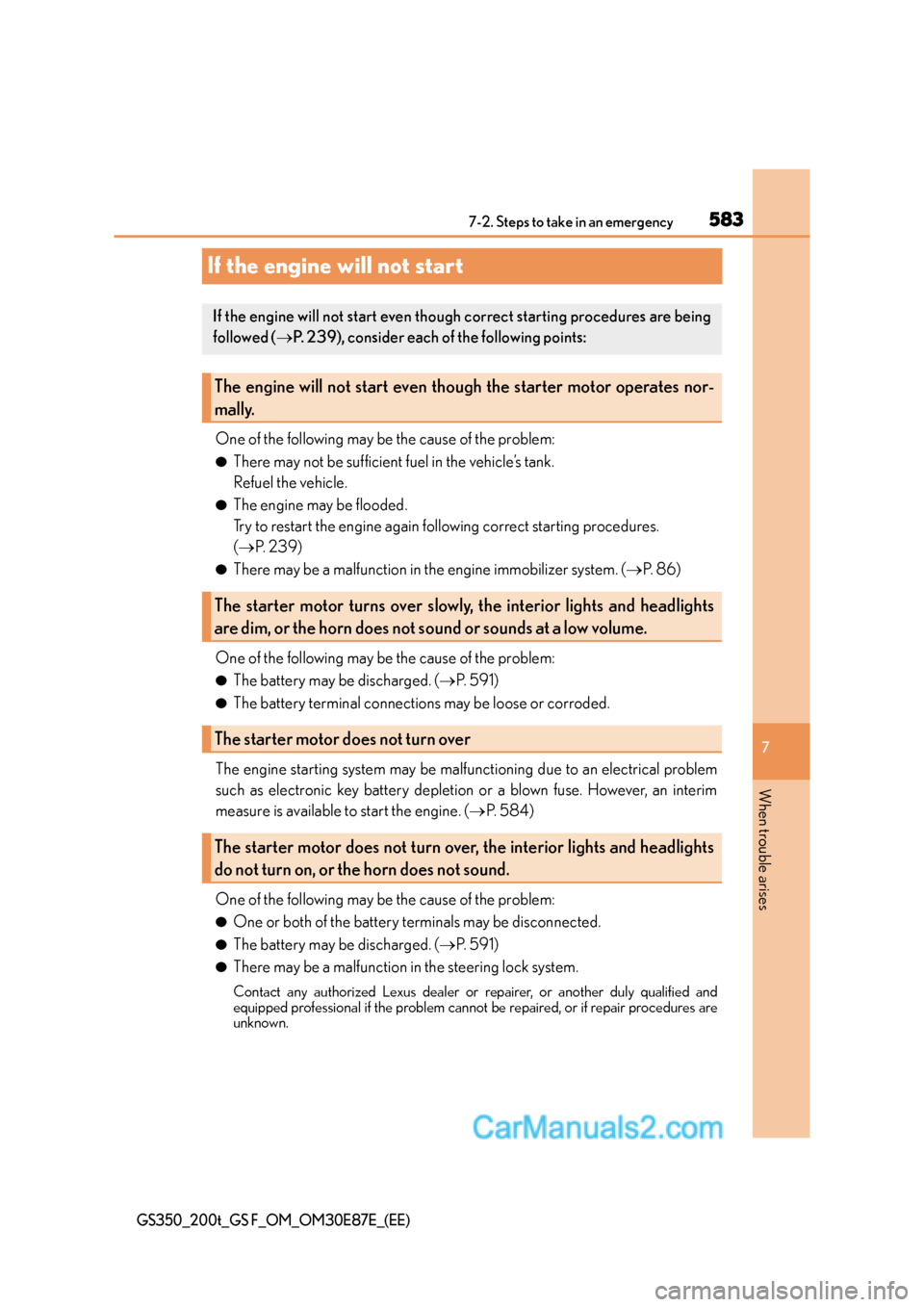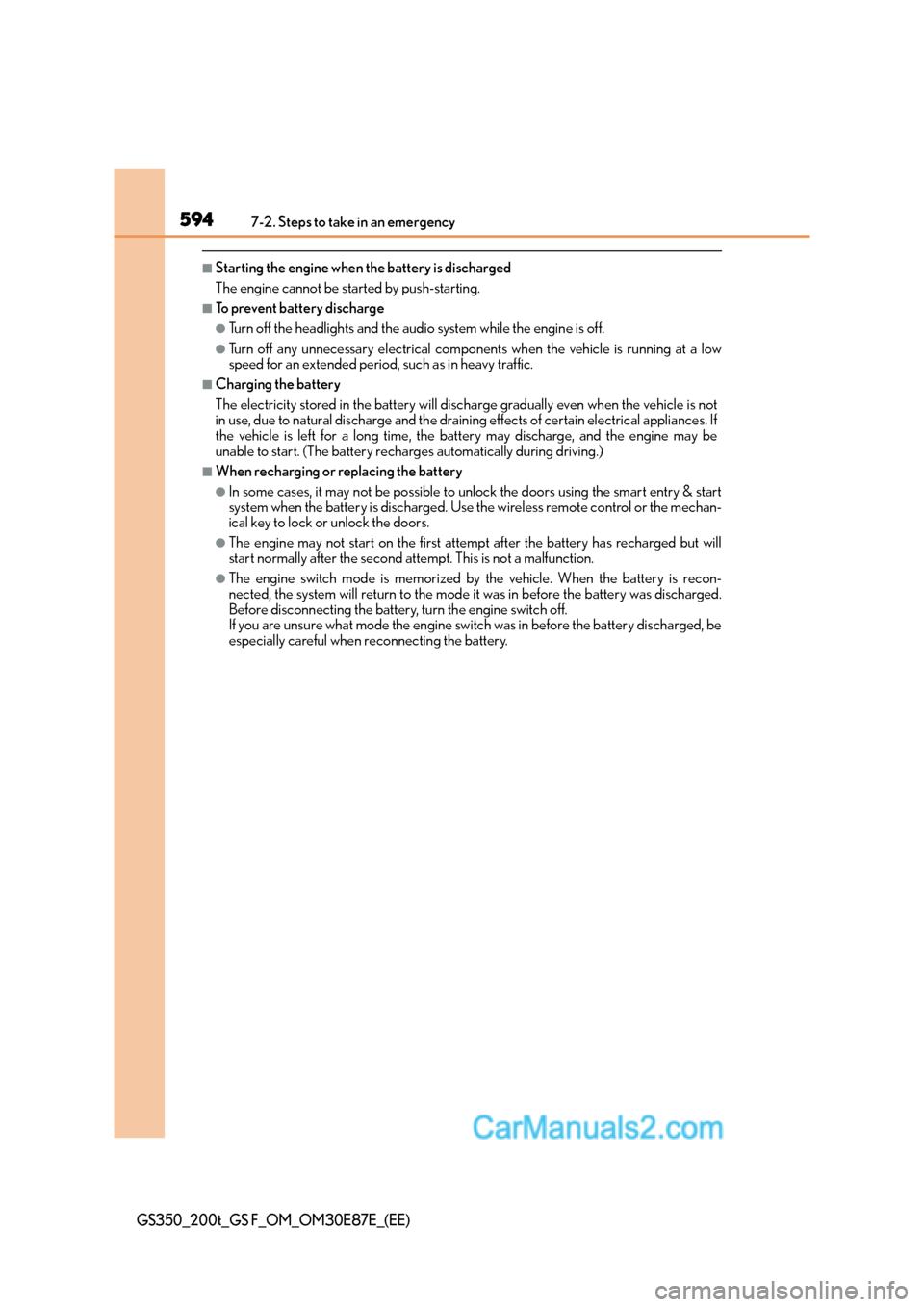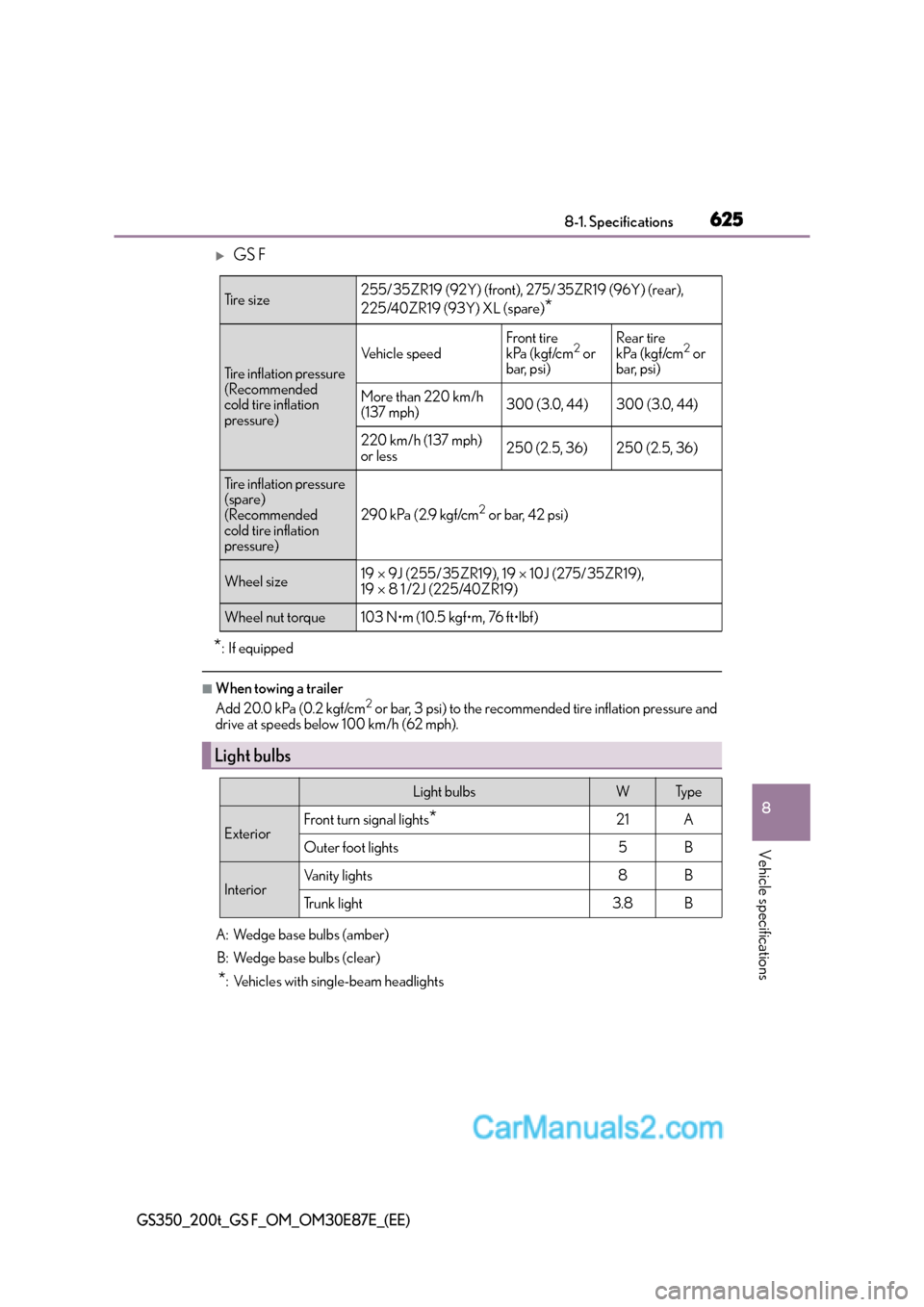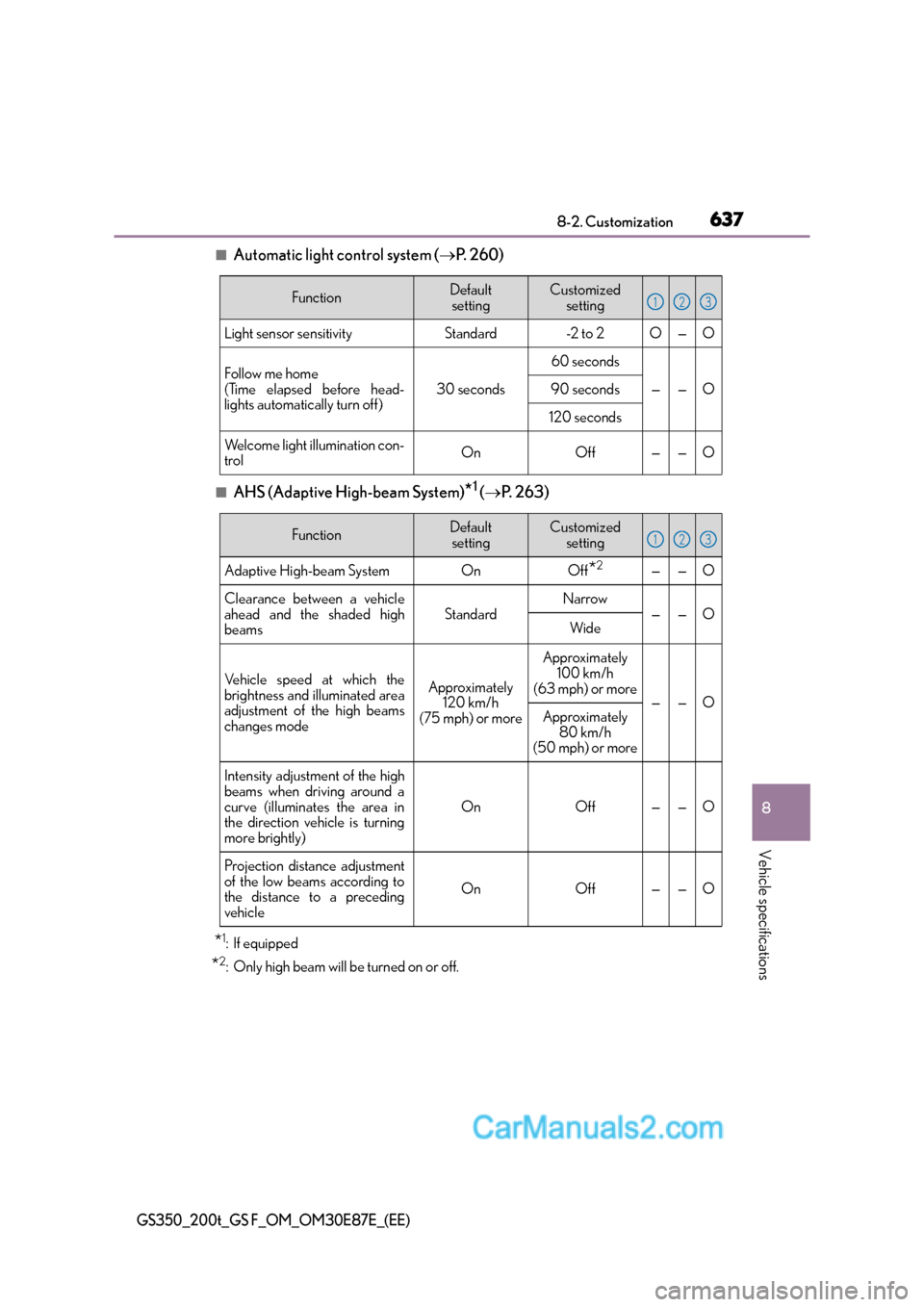2016 Lexus GS200t lights
[x] Cancel search: lightsPage 583 of 668

583
7
7-2. Steps to take in an emergency
When trouble arises
GS350_200t_GS F_OM_OM30E87E_(EE)
If the engine will not start
One of the following may be the cause of the problem:
●There may not be sufficient fuel in the vehicle’s tank.
Refuel the vehicle.
●The engine may be flooded.
Try to restart the engine again following correct starting procedures.
(
→ P. 2 3 9 )
●There may be a malfunction in the engine immobilizer system. ( →P. 8 6 )
One of the following may be the cause of the problem:
●The battery may be discharged. ( →P. 5 9 1 )
●The battery terminal connections may be loose or corroded.
The engine starting system may be malfunctioning due to an electrical problem
such as electronic key battery depletion or a blown fuse. However, an interim
measure is available to start the engine. ( →P. 5 8 4 )
One of the following may be the cause of the problem:
●One or both of the battery terminals may be disconnected.
●The battery may be discharged. ( →P. 5 9 1 )
●There may be a malfunction in the steering lock system.
Contact any authorized Lexus dealer or repairer, or another duly qualified and
equipped professional if the problem cannot be repaired, or if repair procedures are
unknown.
If the engine will not start even though correct starting procedures are being
followed ( →P. 239), consider each of the following points:
The engine will not start even thou gh the starter motor operates nor-
mally.
The starter motor turns over slowly , the interior lights and headlights
are dim, or the horn does not so und or sounds at a low volume.
The starter motor does not turn over
The starter motor does not turn over , the interior lights and headlights
do not turn on, or the horn does not sound.
Page 594 of 668

5947-2. Steps to take in an emergency
GS350_200t_GS F_OM_OM30E87E_(EE)
■Starting the engine when the battery is discharged
The engine cannot be started by push-starting.
■To prevent battery discharge
●Turn off the headlights and the audio system while the engine is off.
●Turn off any unnecessary electrical components when the vehicle is running at a low
speed for an extended period, such as in heavy traffic.
■Charging the battery
The electricity stored in the battery will discharge gradually even when the vehicle is not
in use, due to natural discharge and the draining effects of certain electrical appliances. If
the vehicle is left for a long time, the battery may discharge, and the engine may be
unable to start. (The battery recharges automatically during driving.)
■When recharging or replacing the battery
●In some cases, it may not be possible to un lock the doors using the smart entry & start
system when the battery is discharged. Use the wireless remote control or the mechan-
ical key to lock or unlock the doors.
●The engine may not start on the first attempt after the battery has recharged but will
start normally after the second attempt. This is not a malfunction.
●The engine switch mode is memorized by the vehicle. When the battery is recon-
nected, the system will return to the mode it was in before the battery was discharged.
Before disconnecting the battery, turn the engine switch off.
If you are unsure what mode the engine switch was in before the battery discharged, be
especially careful when reconnecting the battery.
Page 625 of 668

625
8
8-1. Specifications
Vehicle specifications
GS350_200t_GS F_OM_OM30E87E_(EE)
�XGS F
*: If equipped
■When towing a trailer
Add 20.0 kPa (0.2 kgf/cm2 or bar, 3 psi) to the recommended tire inflation pressure and
drive at speeds below 100 km/h (62 mph).
Ti r e s i z e255/35ZR19 (92Y) (front), 275/35ZR19 (96Y) (rear),
225/40ZR19 (93Y) XL (spare)
*
Tire inflation pressure
(Recommended
cold tire inflation
pressure)
Vehicle speedFront tire
kPa (kgf/cm2 or
bar, psi)Rear tire
kPa (kgf/cm2 or
bar, psi)
More than 220 km/h
(137 mph)300 (3.0, 44)300 (3.0, 44)
220 km/h (137 mph)
or less250 (2.5, 36)250 (2.5, 36)
Tire inflation pressure
(spare)
(Recommended
cold tire inflation
pressure)
290 kPa (2.9 kgf/cm2 or bar, 42 psi)
Wheel size19 × 9J (255/35ZR19), 19 × 10J (275/35ZR19),
19 × 8 1 /2J (225/40ZR19)
Wheel nut torque103 N•m (10.5 kgf•m, 76 ft•lbf)
Light bulbs
Light bulbsWTy p e
ExteriorFront turn signal lights*21A
Outer foot lights5B
InteriorVanity lights8B
Trunk light3.8B
A: Wedge base bulbs (amber)
B: Wedge base bulbs (clear)
*: Vehicles with single-beam headlights
Page 637 of 668

637
8
8-2. Customization
Vehicle specifications
GS350_200t_GS F_OM_OM30E87E_(EE)
■Automatic light control system (
→P. 2 6 0 )
■AHS (Adaptive High-beam System)*1 (→ P. 2 6 3 )
*1: If equipped
*2: Only high beam will be turned on or off.
FunctionDefault
settingCustomized setting
Light sensor sensitivityStandard-2 to 2O—O
Follow me home
(Time elapsed before head-
lights automatically turn off)
30 seconds
60 seconds
——O90 seconds
120 seconds
Welcome light illumination con-
trolOnOff——O
123
FunctionDefault
settingCustomized setting
Adaptive High-beam SystemOnOff*2——O
Clearance between a vehicle
ahead and the shaded high
beamsStandardNarrow——OWide
Vehicle speed at which the
brightness and illuminated area
adjustment of the high beams
changes modeApproximately 120 km/h
(75 mph) or more
Approximately 100 km/h
(63 mph) or more
——OApproximately
80 km/h
(50 mph) or more
Intensity adjustment of the high
beams when driving around a
curve (illuminates the area in
the direction vehicle is turning
more brightly)
OnOff——O
Projection distance adjustment
of the low beams according to
the distance to a preceding
vehicle
OnOff——O
123
Page 641 of 668

641
8
8-2. Customization
Vehicle specifications
GS350_200t_GS F_OM_OM30E87E_(EE)
■Illumination (
→P. 4 1 4 )
FunctionDefault
settingCustomized setting
Interior lights illumination con-
trolOnOff——O
Time elapsed before the inte-
rior lights turn off15 seconds7. 5 s e c o n d sO—O30 seconds
Operation after the engine
switch is turned offOnOff——O
Operation when the doors are
unlockedOnOff——O
Operation when you approach
the vehicle with the electronic
key on your person (vehicles
with entry function)
OnOff——O
Footwell lightingOnOff——O
Outer foot lightsOnOff——O
Time elapsed before the outer
foot lights turn off15 seconds
Off
O—O7. 5 s e c o n d s
30 seconds
Enable/disable operation of the
outer foot lights when you
approach the vehicle with the
electronic key on your person
OnOff——O
Enable/disable operation of the
outer foot lights when the doors
are unlocked with the power
door lock switch
OnOff——O
123
Page 653 of 668

653Alphabetical index
GS350_200t_GS F_OM_OM30E87E_(EE)
Clock ............................................... 109, 427
Coat hooks .............................................. 432
Condenser .............................................460
Console box ............................................ 418
Console box light................................... 419
Coolant .....................................................458Capacity .................................................. 619
Checking .............................................. 458
Preparing and checking before winter ....................................382
Cooling system......................................458 Engine overheating ......................... 596
Cruise control Cruise control .....................................353
Dynamic radar cruise control with full-speed range.................... 329
Dynamic radar cruise control .......341
Cup holders ............................................. 419
Curtain shield airbags ............................ 51
Customizable features .......................628
DAB (Digital Audio Broadcast)
*
Daytime running light system ......... 262
Defogger Front windshield ................................ 400
Outside rear view mirrors............ 400
Rear window ....................................... 400
Differential Front differential....................................621
Rear differential .....................................621 Digital Audio Broadcast (DAB)
*
Dimensions ............................................. 606
Display
12.3-inch display ................................ 392
Drive information.......................122, 130
Dynamic radar cruise control
with full-speed range ................... 329
Dynamic radar cruise control ....... 341
LDA (Lane Departure Alert with steering control)..................... 319
LKA (Lane-Keeping Assist) ..........310
Multi-information display.........121, 129
Trip information ...........................108, 113
Warning message ..............................518
Do-it-yourself maintenance ............. 443
Door courtesy lights Location ................................................... 414
Wattage ................................................. 625
Door lock Doors......................................................... 159
Smart entry & start system ............. 173
Wireless remote control ................. 154
Doors ............................................................... 159
Automatic door locking and
unlocking system ............................. 163
Door glasses.......................................... 213
Door lock ................................................ 162
Open door warning buzzer .......... 174
Open door warning light ................ 514
Outside rear view mirrors .............. 210
Rear door child-protector ............. 163
D
*: Refer to the “NAVIGATION AND MULTIMEDIA SYSTEM OWNER’S MANUAL”.
Page 655 of 668

655Alphabetical index
GS350_200t_GS F_OM_OM30E87E_(EE)
Emergency brake signal .................... 375
Emergency flashers .............................502
Emergency tire puncture repair kit ................................................ 567
Engine......................................................... 610 Accessory mode................................ 240
Compartment......................................448
Engine switch....................................... 239
Hood ........................................................445
How to start the engine .................. 239
Identification number ...................... 609
Ignition switch
(engine switch) ................................ 239
Overheating ........................................ 596
Engine compartment cover .............. 451
Engine coolant .......................................458 Capacity .................................................. 619
Checking .............................................. 458
Preparing and checking before winter ....................................382
Engine coolant temperature gauge.......................................................108
Engine oil.................................................. 453 Capacity ...................................................612
Checking ...............................................453
Oil level warning message ............ 518
Oil pressure warning message............................................... 518
Preparing and checking before winter ....................................382 Engine switch ......................................... 239
Auto power off function ................... 241
Changing the engine switch modes.................................................. 240
If your vehicle has to be stopped in an emergency ......... 503
Starting the engine............................ 239
EPS (Electric Power Steering) ....... 375
Function.................................................. 375
Warning light......................................... 513
Warning message ..............................518
Expert mode............................................377
First-aid kit storage net ...................... 423
Flat tire
Vehicles with spare tire....................551
Vehicles without spare tire........... 567
Floor mats ................................................... 42
Fluid Automatic transmission.................. 620
Brake ........................................................622
Washer ................................................... 464
Fog lights .................................................. 273
Replacing light bulbs ....................... 498
Switch .......................................................273
Follow me home system ......................261
Footwell light ............................................ 414
Front air conditioning system .......... 394
Front fog lights ....................................... 273 Replacing light bulbs ....................... 498
Switch .......................................................273
F
*: Refer to the “NAVIGATION AND MULTIMEDIA SYSTEM OWNER’S MANUAL”.
Page 656 of 668

656Alphabetical index
GS350_200t_GS F_OM_OM30E87E_(EE)
Front personal lights ............................. 415
Front position lights.............................. 260Light switch ...........................................260
Replacing light bulbs....................... 498
Welcome light illumination control................................................... 160
Front seats ................................................ 195 Adjustment ............................................. 195
Cleaning.................................................438
Correct driving posture .................... 44
Driving position memory ................ 198
Head restraints....................................203
Power easy access system ............ 198
Seat heaters ........................................... 410
Seat position memory ...................... 198
Seat ventilators ..................................... 410
Front turn signal lights......................... 253 Replacing light bulbs........... 493, 498
Turn signal lever ................................. 253
Wattage..................................................625
Fuel ............................................................ 280 Capacity .................................................... 611
Fuel gauge..................................... 108, 113
Fuel pump shut off system................ 511
Information ............................................626
Refueling ............................................... 280
Type ............................................................. 611
Warning light .........................................514
Warning messages............................ 518
Fuel consumption
Average fuel consumption............................ 122, 130
Average fuel consumption after refueling .......................... 122, 130
Current fuel consumption.... 122, 130 Fuel filler door ........................................ 280
Refueling ................................................ 280
When the fuel filler door cannot be opened......................... 282
Fuel pump shut off system ................... 511
Fuses .......................................................... 487
Gauges ..............................................108, 113
Glove box................................................. 418
Glove box light ....................................... 418
Hands-free system (for cellular phone)
*
Head restraints ...................................... 203
Headlight cleaner...................... 275, 276
Headlights ............................................... 260 Adaptive Front-lighting
System (AFS)..................................... 261
AHS (Adaptive High-beam
System) ............................................... 263
Automatic High Beam
system.................................................. 268
Follow me home system.................. 261
Headlight leveling warning message ...............................................518
Light switch........................................... 260
Replacing light bulbs ....................... 498
Head-up display....................................... 141
Heated steering wheel....................... 409
G
H